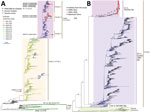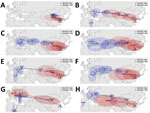Disclaimer: Early release articles are not considered as final versions. Any changes will be reflected in the online version in the month the article is officially released.
Author affiliations: Institute of Microbiology, Center for Influenza Research and Early-warning (CASCIRE), Chinese Academy of Sciences–The World Academy of Sciences Center of Excellence for Emerging Infectious Diseases, Chinese Academy of Sciences, Beijing, China (J. Yang, Chunge Zhang, J. Sun, W. Liu, G.F. Gao, Y. Bi); University of Chinese Academy of Sciences, Beijing (J. Yang, Chunge Zhang, W. Liu, G.F. Gao, Y. Bi); Shandong First Medical University, Taian, China (Y. Yuan, W. Shi, Y. Bi); Shanxi Agricultural University, Taigu, China (J. Sun, Y. Bi); University of Edinburgh, Edinburgh, UK (L. Lu, P. Digard, S. Lycett); China Agricultural University, Beijing (Honglei Sun); State Forestry and Grassland Administration, Shenyang, China (Heting Sun, D. Chu, S. Qin); Wuhan Institute of Virology, Chinese Academy of Sciences, Wuhan, China (J. Chen); Ordos Forestry and Grassland Development Center, Ordos, China (Chengbo Zhang); Hohhot Center for Disease Control and Prevention, Hohhot, China (X. Hao)
Since the Gs/GD/96-lineage highly pathogenic avian influenza virus (HPAIV) (H5N1) was identified in 1996, H5 HPAIVs have evolved into divergent clades and caused continuous outbreaks in birds (1–11). Moreover, long-distance transmissions of H5 HPAIVs within a relatively short period indicate a crucial role of migratory birds in global spread of HPAIVs (7,8). Thus far, H5 viruses have undergone at least 4 waves of intercontinental transmission: H5N1 clade 2.2 during 2005–2006, H5N1 clade 2.3.2.1c during 2009–2010, H5N8 clade 2.3.4.4a and H5N1 clade 2.3.2.1c during 2014–2015, and H5Ny clade 2.3.4.4b during 2016–2017 (2–8).
Starting during 2020–2021, a new wave of HPAIV H5N1/H5N8 clade 2.3.4.4b outbreaks was reported in wild and domestic birds in Eurasia (9–11) and Africa (https://wahis.woah.org/#/event-management). Human cases of H5N1/H5N6/H5N8 infection were sporadically documented (https://www.who.int/teams/global-influenza-programme/avian-influenza/monthly-risk-assessment-summary), highlighting the zoonotic risk of H5 HPAIVs. Since 2021, H5 HPAIVs have caused at least 9 outbreaks in wild birds rather than poultry in mainland China (http://www.moa.gov.cn/gk/yjgl_1/yqfb; http://www.xmsyj.moa.gov.cn/yqfb). However, large outbreaks of H5N1 HPAIVs in domestic poultry were reported during 2021–2022 in Europe and the United States (https://www.cdc.gov/flu/avianflu/data-map-commercial.html) (A. Kandeil et al., unpub. data, https://doi.org/10.21203/rs.3.rs-2136604/v1). In this study, we explored the genetic origin, spread patterns, and antigenicity of H5N1 viruses identified from 2 dead migratory birds in China.
We collected oral swab specimens and lung tissues from a dead whooper swan in northern China (Inner Mongolia) on November 3, 2021, and a deceased black swan in eastern China (Zhejiang) on November 15, 2021. We performed virus isolation in 10-day-old specific pathogen-free chicken embryos (12), then confirmed results by quantitative reverse transcription PCR (Mabsky Biotech, http://www.mabsky.com).
We isolated and Sanger sequenced 3 viruses, A/whooper swan/Northern China/11.03 IMEEDSAK1-O/2021 (Ws/NC/AK1-O/2021), A/whooper swan/Northern China/11.03 IMEEDSAK2-O/2021 (Ws/NC/AK2-O/2021), and A/black swan/Eastern China/11.15 ZJHZ74-Lg/2021 (Bs/EC/74-Lg/2021). We deposited whole genomes in NMDC (https://nmdc.cn; accession nos. NMDCN0000RD8–NMDCN0000RDV) and GISAID (https://www.gisaid.org; accession nos. EPI195500–EPI195523). We reconstructed phylogenetic trees for each gene of the 3 H5N1 isolates together with reference viruses from GISAID and the National Center for Biotechnology Information (https://www.ncbi.nlm.nih.gov/genomes/FLU/Database/nph-select.cgi), using the maximum-likelihood method with a general time-reversible model plus gamma distribution in RAxML 8.2.12 (https://cme.h-its.org/exelixis/web/software/raxml) (Appendix 1 Table). We reconstructed Bayesian time-resolved phylogenetic trees in BEAST 1.10.4 (https://beast.community/index.html) using the SRD06 model, the log-normal relaxed clock model, and the Skygrid coalescent model. We mapped spatial coordinates to the post burn-in time-scaled posterior trees using a Brownian motion continuous phylogeographic model. We mapped host type and hemagglutinin (HA) or neuraminidase (NA) subtype on each posterior tree by using a discrete trait phylogeographic model with BSSVS extension to infer the most likely ancestor with statistical support (Appendix 2).
We performed hemagglutination inhibitor (HI) assays (https://www.who.int/publications/i/item/manual-for-the-laboratory-diagnosis-and-virological-surveillance-of-influenza) to test the reactivities of antiserum of H5 Re-11/Re-13/Re-14 vaccines against these new H5N1 isolates and H5N8 HPAIVs identified in 2020 (10). Re-11 (A/duck/Guizhou/S4184/2017[H5N6], clade 2.3.4.4h) was used in poultry in China during December 2018–December 2021, whereas Re-13 (A/duck/Fujian/S1424/2020[H5N6], clade 2.3.4.4h) and Re-14 (A/whooper swan/Shanxi/4–1/2020[H5N8], clade 2.3.4.4b) have been deployed since January 2022 (http://www.moa.gov.cn/govpublic).
We obtained 3 H5N1 HPAIVs, Ws/NC/AK1-O/2021 and Ws/NC/AK2-O/2021 from a dead whooper swan in northern China and Bs/EC/74-Lg/2021 from a dead black swan in eastern China in November 2021. Consistent with the HPAIV signature of multiple basic amino acids on HA cleavage site, these H5N1 strains caused severe histopathologic changes in the wild birds (Appendix 2 Figure 1).
Figure 1

Figure 1. Phylogenetic trees for hemagglutinin genes of clade 2.3.4.4 H5Ny and neuraminidase genes of global H5N1 avian influenza viruses. A) Phylogeny of hemagglutinin genes of global clade 2.3.4.4 H5Ny avian influenza...
Phylogenetic analyses showed that all 3 H5N1 HA genes cluster in clade 2.3.4.4b.2 (Figure 1, panel A). Most H5 avian influenza viruses (AIVs) identified during 2020–2021 were in that clade, whereas H5N8 was the dominant subtype during 2019–2021, and H5N1 strains emerged in October 2020 and increased subsequently. In NA phylogeny, most H5N1 viruses identified during 2020–2021 including those 3 H5N1 viruses, were classified into the Eurasian lineage clade EA-3 (Figure 1, panel B). However, almost all H5N1 NA genes from mainland China were identified during 1996–2018 and are clade EA-1.
Given the HA phylogenetic relationships, we defined cluster 1, 2, and 3 in clade 2.3.4.4b.2 (Figure 1, panel A). Cluster 1 includes 4 H5N8 HPAIVs identified from wild birds in 2020 (10) and Re-14 vaccine strain. In cluster 2, Bs/EC/74-Lg/2021 was grouped with H5N1 viruses from Japan and South Korea, showing 99.3%–99.6% sequence identity. In cluster 3, Ws/NC/AK1-O/2021 and Ws/NC/AK2-O/2021 are identical (Appendix 2 Table 1) and clustered with H5N1 viruses from Europe, possessing 99.3% nucleotide identity. Most H5N1 viruses identified during 2020–2021 belong to cluster 3. Notably, 8 H5N6 and 1 H5N8 viruses that caused human infections (13) are found in cluster 1. Moreover, 2 human infections with cluster 3 H5N1 viruses were reported in the United Kingdom and United States during 2021–2022 (14). Therefore, this virus lineage poses a nonnegligible threat to public health, despite these viruses carrying non–mammalian-adapted molecular markers (Appendix 2 Table 2) and avian-type receptor-binding propensity (Appendix 2 Figure 2).
Current H5N1 viruses have resulted in substantial mortality in domestic and wild birds in Eurasia, Africa, and Americas (https://wahis.woah.org/#/event-management); however, they have only been identified in wild birds in mainland China. Compared with high HI antibody titers (256) between homologous antiserum and antigens of H5 vaccines, the recent H5N1/H5N8 viruses presented low HI titers (2–16) against Re-11/Re-13 antiserum (Table 1). In addition, cluster 1 H5N8 viruses had HI titers of 64 against Re-14 (cluster 1) antiserum, whereas HI titers for the H5N1 viruses were 128 for Bs/EC/74-Lg/2021 (cluster 2) and 32 for Ws/NC/AK1-O/2021 (cluster 3). This finding indicates lower antigenic identities between H5N1/H5N8 viruses circulating in wild birds and vaccines used in domestic poultry, even within the same clade. This antigenic variation may correlate to substitutions at antigenic sites (Table 2; Appendix 2 Tables 3,4, Figure 3).
Figure 2

Figure 2. Spread patterns of all 8 gene segments of highly pathogenic avian influenza virus (H5N1), Bs/2021-like and Ws/2021-like reassortants, identified in migratory wild birds in China. Virus spread patterns reconstructed for...
Phylogenetic analyses uncovered that 3 novel H5N1 viruses could be classified into Ws/2021-like (Ws/NC/AK1-O/2021 and Ws/NC/AK2-O/2021) and Bs/2021-like (Bs/EC/74-Lg/2021) reassortants (Appendix 2 Figure 4). The viruses originated through separate reassortment events between H5N8 HPAIVs (obtaining HA and matrix [M] genes) and low pathogenic avian influenza virus pools (NA, polymerase basic 1, polymerase basic 2, polymerase acidic, nucleoprotein, and nonstructural protein genes) (Appendix 2 Figure 5–12). Phylogeographic analyses suggested that the H5N1 viruses spread to China by long-distance bird migration through various routes (Figure 2).
We reconstructed the genetic reassortment history for these H5N1 viruses (Appendix 2 Table 5, Figures 13, 14). For the Bs/2021-like reassortant, most gene segments group with viruses from wild Anseriformes in China or its adjacent areas, whereas the M gene likely originated from an HPAIV H5N8 ancestor from Eastern Europe in approximately May 2021 before import into China through bird migration. For the Ws/2021-like reassortant, 7 gene segments originated from Europe and were potentially transmitted by wild birds in February–August 2021, whereas a unique polymerase basic 2 gene originated from an early ancestry in 2017 with unknown origin but most closely related to a Russian H3N6 low pathogenic AIV. The ancestral states of most genes of the 2 reassortants indicate origins in wild Anseriformes and likely transmission through wild Anseriformes over the summer of 2021, whereas a few genes (e.g., Bs/2021-like M gene) potentially originated from domestic poultry. However, sampling bias in sequences might affect ancestral reconstruction by discrete trait phylogeographic models.
In conclusion, we identified 3 H5N1 HPAIVs in wild birds in autumn 2021, China. The antigenic divergence highlights the high-risk introduction of H5N1 circulating in wild birds to incompletely protected vaccinated flocks in China. The H5N1 viruses have experienced complicated reassortment during long-distance spread through various bird migration routes. Therefore, we call for international cooperation on AIV monitoring in migratory birds to help early identification and intervention of the emerging and reemerging AIVs with public health risks.
Dr. Yang is an assistant professor at the Institute of Microbiology, Chinese Academy of Sciences. Her research interests are focused on the evolution and spread patterns of emerging and reemerging infectious diseases.
We thank the submitters and originating laboratories for influenza virus genomes in the GISAID and National Center for Biotechnology Information databases.
This work was supported by the National Key R&D Program of China (grant nos. 2021YFC2300900 and 2022YFC2601602), National Natural Science Foundation of China (grant nos. 32261133524 and 32200416), Strategic Priority Research Program of Chinese Academy of Sciences (grant no. XDB29010102), Chinese Academy of Sciences’ Southeast Asia Biodiversity Research Institute (grant no. 151C53KYSB20210023), Self-supporting Program of Guangzhou Laboratory (grant no. SRPG22-001), and the National Science and Technology Infrastructure of China (grant no. NPRC-32).
Y.B. is supported by the Youth Innovation Promotion Association of the Chinese Academy of Sciences (grant no. Y2021034) and Innovation Team and Talents Cultivation Program of National Administration of Traditional Chinese Medicine (grant no. ZYYCXTD-D-202208). L.L., S.L., P.D., and W.L. are supported by an Ecology and Evolution of Infectious Diseases collaborative grant with the UK Biotechnology and Biological Sciences Research Council (grant no. BB/V011286/1) and the National Natural Science Foundation of China (grant no. 32061123001). P.D. and S.L. are additionally supported by the Strategic Program grant to Roslin Institute (grant no. BB/P013740/1) and a UK research consortium on avian influenza research gaps (Flu-MAP) (grant no. BB/X006123/1) from the UK Biotechnology and Biological Sciences Research Council and Department for Environment Food and Rural Affairs. P.D. was also supported by an EU Horizon 2020 award (no. 727922 [DELTA-FLU]), and L.L and S.L are supported by an EU Horizon 2020 award (no: 874735 [VEO]).
留言 (0)